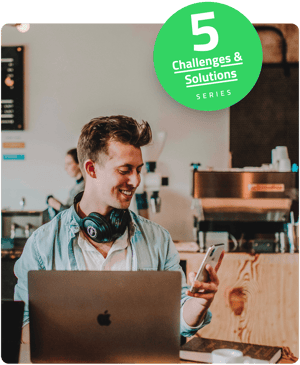

Customer self-service ≠ customer support
Boost revenue and strengthen the customer relationship by giving customers autonomy in a controlled environment.
In B2B subscription businesses, customer self-service is often conflated with customer support instead of genuinely giving consumers autonomy over their purchase and experience. For example, providing FAQs so that customers can solve problems themselves or submit tickets to resolve issues.
At keylight, customer self-service is seen as a part of the sales process and contributes to the entirety of the long-term customer relationship. Revenue opportunities can be generated through timely engagement across the customer lifecycle.
By allowing customers to subscribe and interact with their own subscriptions, including upgrades, downgrades, changing terms, managing invoices and purchasing add ons, the following benefits are unlocked:
Customer Self-Service ≠ Customer Support
Increased sales efficiency
Increasing market share with fewer resources
Additional touchpoints along the customer lifecycle
Customer retention and value growth
Read on to discover the five most common challenges to implementing customer self-service in B2B subscription businesses

A shift in mindset for customer self-service
Giving customers autonomy doesn’t mean losing control over the customer relationship.
The challenge
Many B2B subscription businesses prefer a direct sales approach to the customer journey. In the mindset that’s fearful of giving customers too much autonomy, the business misses opportunities to sell more and retain the customer. Without proper self-service options, customers need to invest more time getting in touch with the organization, which leaves them highly vulnerable to being pushed into another sales cycle. The inconvenience of a lack of autonomy creates emotional barriers and friction in the customer relationship.
The impact
Impact #1
Losing track of customers after the initial sale
Impact #2
Long-term dissatisfied customers without acknowledgment
t
Impact #3
Fragile customer links that are vulnerable to competitive offerings
Impact #4
Infringement of consumer cancellation rights if termination of the contract is made difficult
The keylight solution
Think about self-service as a two-way engagement with customers – pulling the customer to the business instead of pushing them to enter the sales process. By giving customers the power to interact with their own subscriptions, thereby helping to facilitate their own commercial goals, what you gain is a much healthier customer relationship, and far greater insights with digital touchpoints. The key is to create a well-designed self-service environment and use data to take actions at the right time.

Deficient automation of self-service journeys
Self-service processes need to be in line with marketing, sales and support operations.
The challenge
Integrating customer self-service into the software architecture is not easy, especially when it involves enabling self-service upgrades, downgrades and contract changes. Whether building self-service options from scratch or integrating with a commerce portal, it takes ceaseless development effort around the standard CRM, billing and ERP systems. Even if that hefty maintenance and development roadmap are managed, your teams will still be inhibited by an incomplete understanding of the customer without a single point at which all information is gathered to give them a complete picture to take the right actions.
The impact
Impact #1
Siloed processes between departments
Impact #2
Frictions along the customer journey
t
Impact #3
Immense resource investment into customizations and software maintenance
Impact #4
Lack of agility for market changes
The keylight solution
Deploy one subscription engine that has out-of-the-box applications for all user groups. Customer-centric collaborations between teams should not be blocked by misaligned systems. Only when all applications in the subscription ecosystem are created to be user-centric, and with one unified data model, can automation work end-to-end, for users in each department without heavy customization effort.

Limitations to offer differentiated customer experiences
Automate tailored conversion paths for each customer segment.
The challenge
With a direct sales approach, prioritizing customers by deal amount, product line, organizational size or region is often manual but manageable. The challenge occurs when automating the different customer journeys. The businesses’ experiences and offerings need to diversify to communicate the right price values for each segment. However, to roll out, test and optimize these journeys with finance-driven systems is opening a Pandora’s box of customization and workaround challenges.
The impact
Impact #1
High cost of sales if resources are not allocated properly
Impact #2
Long-term costs from purchasing additional tools that complicate the monetization ecosystem
Impact #3
Missed opportunities when different segments have diverse competitive offerings
The keylight solution
Have a rule-based and event-driven approach when designing self-service solutions. This setup is the most flexible and scalable so that your teams not only have access to more customer insights but also the agility to deliver individual experiences to the right customers at the right time and at speed.

Lack of functionality in the customer portal
Understand the parameters of the customer relationship with an additional communication channel.
The challenge
The most common ways customer portals are used are for customers to view their subscription plans, make payments or download invoices. Allowing customers to upgrade, downgrade or cancel by themselves is often overly complex because of the billing impact, not to mention enabling communication of new product updates and directing customers to conversion for free trials or discount campaigns. Not only does this imply a lack of technological capability and innovation, it’s also often where competitive offerings come forth.
The impact
Impact #1
Losing touch with the customer after the initial sale
Impact #2
Churn risk
t
Impact #3
Development costs and technical debt
Impact #4
Missed opportunities
The keylight solution
Buy a capable system with 90% of the required features available out-of-the-box and customize the last 10% to deliver great experiences on your customer self-service roadmap. Portals are a vital part of achieving effective self-service capability objectives, knitting together the customer and business needs, and helping to increase conversion rates as a result. It is important to start with a subscription engine that is not finance-driven but rather one that is built for dynamic user interactions.

Missed opportunities to understand customers
Collecting data along the customer journey is crucial for success.
The challenge
Traditional subscription projects are finance-driven. The customer journey and user experience are then built around the billing ecosystem. This approach leads to long customizations, decoupled systems and homegrown processes which all make collecting data through customer self-service difficult. As a result, the dynamic opportunities presented by the long-term customer relationship do not surface through static revenue reports.
The impact
Impact #1
Siloed data collection
Impact #2
No insights on customer actions
Impact #3
Lack of data foundation for decision making
The keylight solution
An event-driven approach is needed to capture every action your prospects and customers are performing throughout self-service journeys and in the customer portal. Additionally, use one central system to collect logical data. The prolonged customer relationship from subscription models gives businesses time to understand the customers across all lifecycle stages. The valuable behavioral data can also be used to innovate products and reduce risks in customer churn, experimentation, revenue flow and market expansion.

Resolution #1
Healthy customer relationships
By enabling customer self-service, you are pulling customers to the business by providing great experiences, solutions and innovations. This fosters a healthy long-term collaboration that is engaging and mutually beneficial, which, in turn, makes success sustainable.
Resolution #2
Event-driven
The entire subscription ecosystem needs to be event-driven. Customer relationships are dynamic, therefore the application network should be as well. Having the right architecture not only supports sustainable subscription revenue, but also allows your business to scale steadily without heavy customization efforts and investment.
Resolution #3
Out-of-the-box
Focus on building great experiences and your own product, not customizing other vendors’ systems to streamline processes. keylight’s OOTB customer self-service capabilities are built-in to a unified subscription engine. We enable businesses to engage with customers and maximize the customer lifetime value effortlessly.



